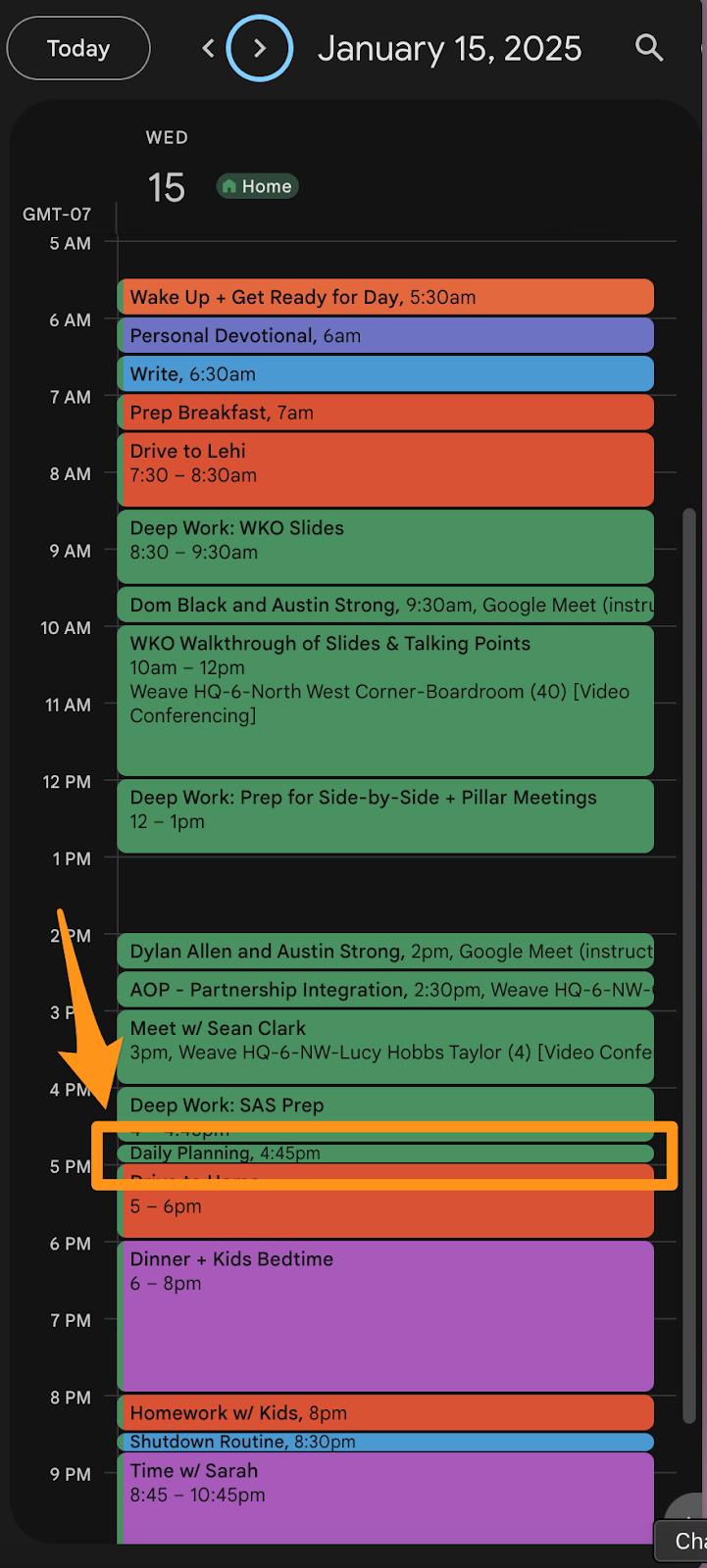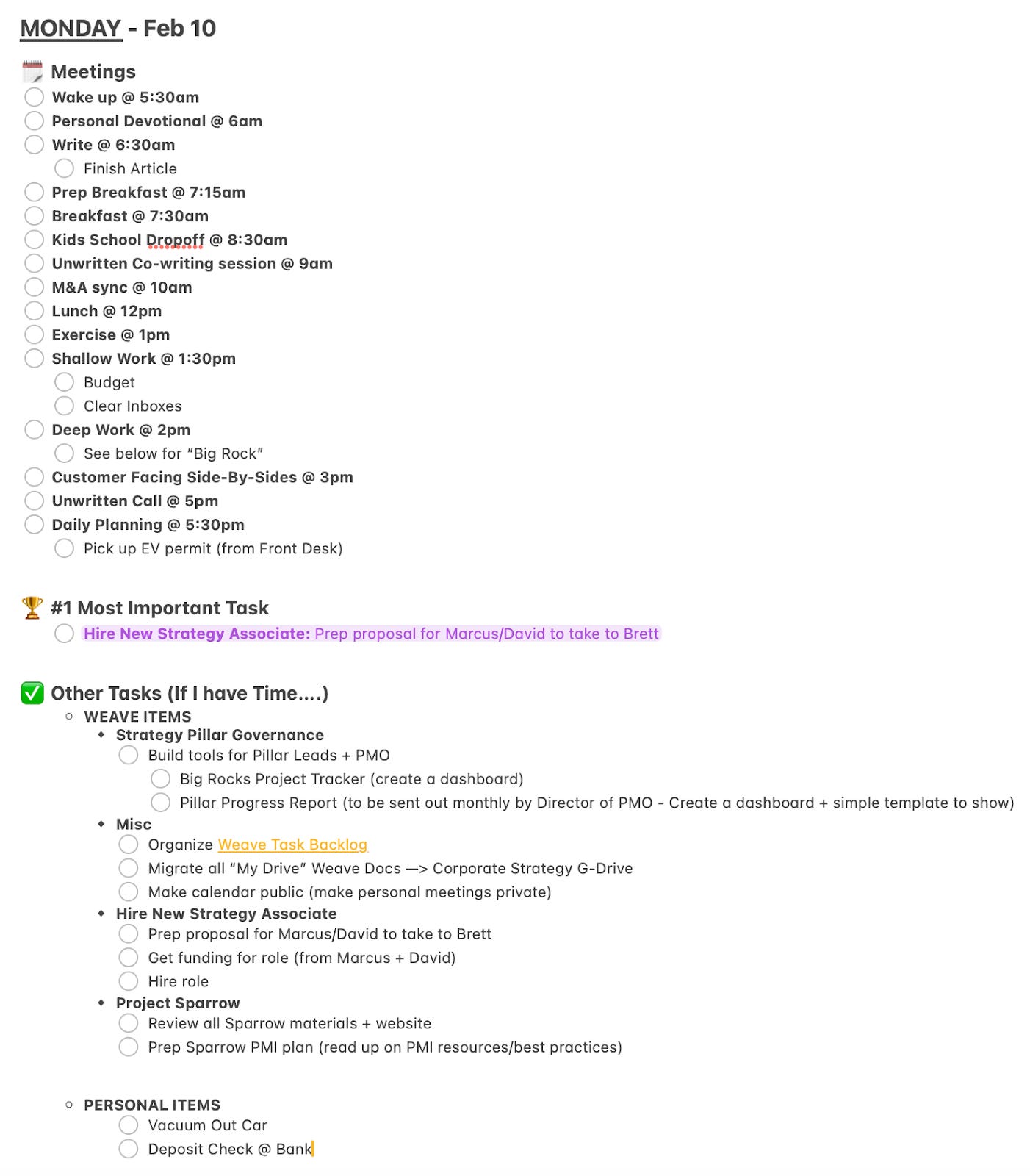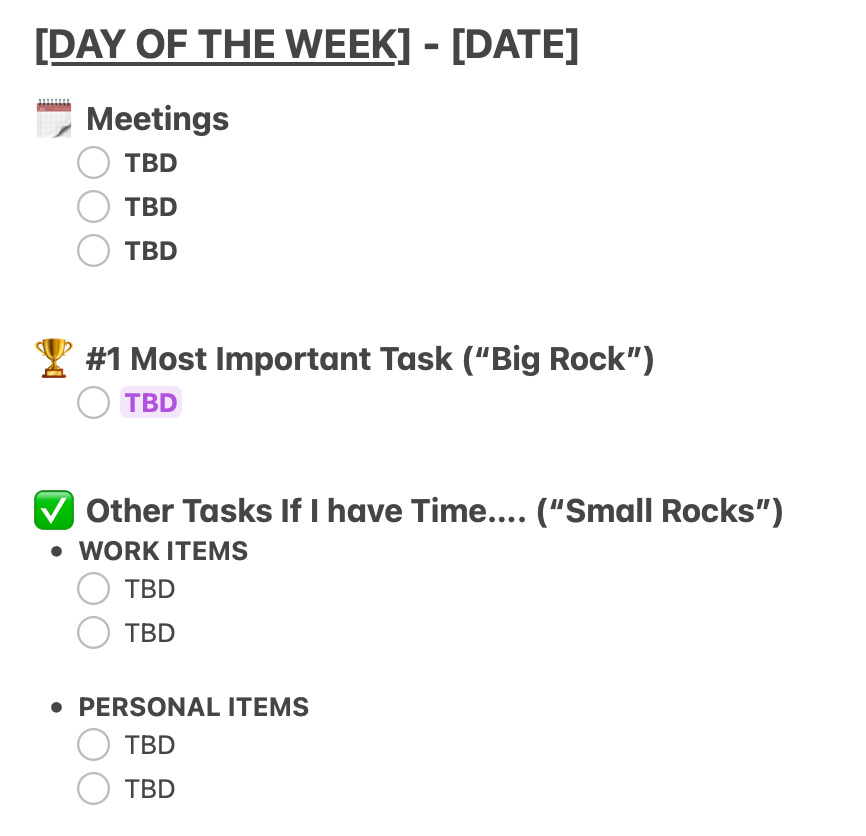My personal secret for staying productive every day = a simple ritual that clarifies tomorrow before it even begins
The Most Important Thing on My Calendar
Last week, one of my coworkers saw my calendar and immediately commented on 3 things:
First: I clearly like to block out and schedule essentially every minute of every day
Second: I have (in their opinion) WAY too much color coding (I have a system okay?!)
Third: What in the world was my “Daily Planning Session”?

I explained to them that simple 20 minute “Daily Planning” block is without question the single most valuable part of my entire day. It is something that I have done every day for 15 years, weekends included. And it’s easily one of the best habits I’ve developed..
Why a Daily Planning Session?
At the end of every workday most people do one of two things: they either race to finish whatever they can before heading home or they mindlessly drift into the evening, letting the day fade into the background. Both approaches waste an opportunity.
The real secret to productivity is understanding a principle I’ve come to believe in with my heart and soul:
A good start doesn’t guarantee a good finish, but a bad start can almost certainly guarantee a bad one.
This principle is obvious when observing other arenas of life. Take track & field races as an example. While there is no definitive data that quantifies how often racers who have a “bad start” off the blocks lose, it’s generally widely understood that this is the case. This is especially true in elite-level track events where reaction times are critical and winners vs. losers are often decided by fractions of a second. We’re inspired by athletes who overcome bad starts during the middle, or especially, the end of a race. But no coach would ever counsel this as a strategy. The chances of winning after coming slow off the blocks are low for a reason.

This is why Daily Planning has become such an essential habit for me. It’s my version of “coming off the block” right from the jump at the beginning of the day, instead of trying to make up for lost momentum. When you’ve decided the night before how you’ll spend each hour of the next day you essentially remove that mental energy from the next morning and can just act.
When I wake up in the morning I know exactly what I’m supposed to be doing, when I’m supposed to do it and what tasks I need to accomplish (vs. which ones will be “nice to haves” if I get them done).
In the wise words of Benjamin Franklin: “By failing to prepare, you are preparing to fail…”
How to Run Your Daily Planning Session
Luckily the daily planning session is quite straightforward. My method usually takes me ~20 minutes or so. It essentially has 3 steps (Reviewing, Prioritizing, Scheduling).
Step 1: Review
Take a few minutes and review what happened during the day. For me this is a simple exercise of writing for ~5 minutes of what went well vs. didn’t. What are my high level feelings about the day’s events? What are the thoughts I want to get on paper?
I usually write short answers to the following prompts:
- What did I do well today?
- What do I wish I’d done differently?
- What are things that are on my mind?
This is something I’ve only started to do for the last 2 years or so, but I’ve been surprised at how helpful it is to just write. You don’t often realize how much effort your subconscious is putting into maintaining thoughts in the back of your mind until you write them down on a paper (or digitally) and recognize that in the act of doing so you no longer need to keep thinking about them.
Importantly, doing this is also great for iterative learning. One of the things you’ll notice when doing this is the patterns. Things that you do (or don’t do) every day that help you get better. Think of this as akin to watching film / gametape of yourself as an athlete and noticing what you need to do better when competing (and also noticing what you’re excelling at!)
For example, after a few months I began to notice how often I was skipping exercise (usually because I felt pressured to get something done at work and thought that “I didn’t have the time”). I also began to notice how frequently I wrote down how that frustrated me. This prompted a change where I now rarely miss a workout day (even if my workout ends up being a few minutes).
Step 2: Prioritize
After clearing the mental clutter, it’s time to identify what the #1 most important thing to do tomorrow is.
This is a concept I picked up from my boss who told me that he’s completely comfortable shutting down at the end of the day as long as he’s done the most important thing on his list. At the time that was very hard for a “checklist achiever” like myself to understand. I chronically felt guilt for all the unchecked items on my to-do list (which was always too long and rarely fully completed). Since then, I’ve understood that it’s a very liberating principle to adopt.
If you’ve identified the single “big rock” in your day, and then achieve it, you’ll be amazed at how rapidly you’ll make progress towards your goals (whether professional or otherwise).
The trick here is that you can only select 1 thing. There’s a deep irony in claiming that you have multiple priorities. As Greg McKeown, author of Essentialism, has aptly pointed out:
“The word priority came into the English language in the 1400s. It was singular. It meant the very first or prior thing. It stayed singular for the next five hundred years. Only in the 1900s did we pluralize the term and start talking about priorities. Illogically, we reasoned that by changing the word we could bend reality.”
The solution to this? Make 2 lists of tasks:
- The #1 Most Important Thing (this by rule, can only have one thing on it. No more. No less. No exceptions)
- “If I Have the Time / Stuff I may get to” (this can have multiple tasks. Sometimes it may be 5 other tasks. Sometimes 20. But the very nature of this list is stuff that you may get to, but are not obligated to do. Simply naming it this takes the pressure off. If you don’t get to these tasks in the day don’t lose any sleep over it)
Step 3: Schedule
This is the final step. You then need to update your calendar to reflect how you’re going to spend your time on the following day.
The first, and most important, thing to do is block off time for accomplishing your “#1 most Important Thing” (aka your Big Rock). Everything else in the day should be scheduled around this. Move meetings if you have to.
Then afterwards, make sure you block off time for everything else. And by everything else I mean everything else: time to exercise, time for dinner, time to read, time to spend with family, time for work meetings. Remember that you can only be in 1 place at one time. To pretend otherwise is irrational.
Once you’ve done this, write down your checklist. It should mirror your calendar exactly. I just do mine in Apple Notes (since I can then easily carry my “daily plan” with me throughout the day, but you can do it in whatever app/tool you think is best (ex: OneNote, Evernote, or even just a plain pad of paper + pencil).
Here is an example of what mine looks like (you’ll notice that in some cases I write down what I need to do during a certain meeting or time block…)

A final tip: If you’re someone who easily loses track of time (like I am) then I also highly recommend Step 3B = setting alarms on your phone the night before your next day starts. I usually set timers to go off ~5 minutes before I need to be anywhere. You can read more about this particular habit here.
A Final Takeaway
My approach isn’t for everyone.
To others it may seem overly organized or rigid. There are almost certainly tradeoffs from being too regimented. But something I want people to understand is that (1) as long as you get your #1 task (big rock) done, it really is okay to let the other stuff slip, and (2) sometimes you just have to “roll with the pouches” (ex: you had a plan on paper but then you had an unexpected event happen and you need to change your plans; which is perfectly fine!). The important thing is to just have a plan in the first place and then be flexible.
The real benefit of a daily planning session isn’t just efficiency. It’s control. Instead of reacting to the day as it comes, you step into it already knowing what matters. A planned day is easier to execute. The decisions are already made. You just look at (1) your calendar, and (2) your daily plan for the answers.
As former UK prime Minister Margaret Thatcher once quipped:
“Plan your work for today and every day, then work your plan”
The best part? Tomorrow, when you start working, you won’t need to ask, What should I do first? You’ll already know
A few “Daily Planning” tools you may find helpful…
If you’re new to this you may find some of our prior “productivity” articles helpful. We’ve also included an example Daily Planning
Other Articles:
Daily Planning Template:



